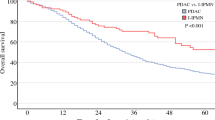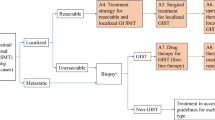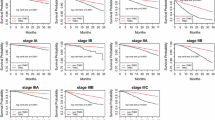Abstract
Purpose
Salivary gland carcinomas (SGC) are rare malignancies and data regarding treatment outcomes stratified by histologic subtype are currently limited. This study aims to examine current, national treatment patterns and overall survival (OS) of patients with the major histologic subtypes of salivary gland carcinoma.
Subjects and methods
A review was performed of the National Cancer Database (NCDB) of patients with confirmed diagnoses of mucoepidermoid carcinoma, acinic cell carcinoma, adenoid cystic carcinoma, adenocarcinoma, or carcinoma ex pleomorphic receiving curative treatment between 2004 and 2014. Univariate and multivariate regression modeling were performed to identify risk factors significantly associated with overall survival (OS). Adjusted survival analyses stratified by treatment and staging were performed with the primary outcome of overall survival (OS) and were further stratified based on histologic subtype.
Results
The final analysis included 7342 patients [3547 men (48.3%) and 3795 women (51.7%); mean age 58.3 years (range 18–90 years)]. Mucoepidermoid carcinoma was the most common histology encountered [n = 2669 (36.4%)]. Unadjusted and adjusted analysis demonstrated improved survival with surgery and radiation therapy (RT) for adenoid cystic (HR = 0.69; p = 0.029), adenocarcinoma (HR = 0.61; p < 0.001), high-grade mucoepidermoid carcinoma (HR = 0.70; p = 0.026), and carcinoma ex pleomorphic (HR = 0.64; p = 0.028), while surgery with chemoradiation therapy (CRT) was associated with worse OS regardless of histologic subtype. The impact of advanced stage on survival varied amongst the histologic subtypes but portended the worst prognosis for patients with adenocarcinoma and carcinoma ex pleomorphic.
Conclusions
The results of this NCDB review demonstrate unique treatment patterns and survival outcomes for SGC based on major histologic subtype.




Similar content being viewed by others
References
Boukheris H, Curtis RE, Land CE, Dores GM (2009) Incidence of carcinoma of the major salivary glands according to the WHO classification, 1992 to 2006: a population-based study in the United States. Cancer Epidemiol Biomarkers Prev 18:2899–2906. https://doi.org/10.1158/1055-9965.EPI-09-0638
Spitz MR, Fueger JJ, Goepfert H, Newell GR (1990) Salivary gland cancer: a case-control investigation of risk factors. Arch Otolaryngol Head Neck Surg 116:1163–1166. https://doi.org/10.1001/archotol.1990.01870100057012
Pan SY, De Groh M, Morrison H (2017) A case-control study of risk factors for salivary gland cancer in Canada. J cancer epidemiol. https://doi.org/10.1155/2017/4909214
Adelstein DJ, Koyfman SA, El-Naggar AK, Hanna EY (2012) Biology and management of salivary gland cancers. Semin Radiat Oncol 22:245–253. https://doi.org/10.1016/j.semradonc.2012.03.009
Schoenfeld JD, Sher DJ, Norris CM, Haddad RI, Posner MR, Balboni TA et al (2012) Salivary gland tumors treated with adjuvant intensity-modulated radiotherapy with or without concurrent chemotherapy. Int J Radiat Oncol Biol Phys 82:308–314. https://doi.org/10.1016/j.ijrobp.2010.09.042
Mifsud MJ, Burton JN, Trotti AM, Padhya TA (2016) Multidisciplinary management of salivary gland cancers. Cancer Control 23:242–248
Lim CM, Hobson C, Kim S, Johnson JT (2015) Clinical outcome of patients with carcinoma ex pleomorphic adenoma of the parotid gland: a comparative study from a single tertiary center. Head Neck 37:543–547. https://doi.org/10.1002/hed.23638
Suzuki M, Matsuzuka T, Saijo S, Takahara M, Harabuchi Y, Okuni T et al (2016) Carcinoma ex pleomorphic adenoma of the parotid gland: a multi-institutional retrospective analysis in the Northern Japan Head and Neck Cancer Society. Acta Otolaryngol 136:1154–1158. https://doi.org/10.1080/00016489.2016.1191671
Alfieri S, Granata R, Bergamini C, Resteghini C, Bossi P, Licitra LF et al (2017) Systemic therapy in metastatic salivary gland carcinomas: a pathology-driven paradigm? Oral Oncol 66:58–63. https://doi.org/10.1016/j.oraloncology.2016.12.016
Terhaard CHJ, Lubsen H, Rasch CRN, Levendag PC, Kaanders HHÀM, Tjho-Heslinga RE et al (2005) The role of radiotherapy in the treatment of malignant salivary gland tumors. Int J Radiat Oncol Biol Phys 61:103–111. https://doi.org/10.1016/j.ijrobp.2004.03.018
Jegadeesh N, Liu Y, Prabhu RS, Magliocca KR, Marcus DM, Higgins KA et al (2015) Outcomes and prognostic factors in modern era management of major salivary gland cancer. Oral Oncol 51:770–777. https://doi.org/10.1016/j.oraloncology.2015.05.005
Mahmood U, Koshy M, Goloubeva O, Suntharalingam M (2011) Adjuvant radiation therapy for high-grade and/or locally advanced major salivary gland tumors. Arch Otolaryngol Head Neck Surg 137:1025–1030. https://doi.org/10.1001/archoto.2011.158
Hosni A, Huang SH, Goldstein D, Xu W, Chan B, Hansen A et al (2016) Outcomes and prognostic factors for major salivary gland carcinoma following postoperative radiotherapy. Oral Oncol 54:75–80. https://doi.org/10.1016/j.oraloncology.2015.11.023
Chung MP, Tang C, Chan C, Hara WY, Loo BW, Kaplan MJ et al (2013) Radiotherapy for nonadenoid cystic carcinomas of major salivary glands. Am J Otolaryngol Head Neck Med Surg 34:425–430. https://doi.org/10.1016/j.amjoto.2013.03.007
Lee A, Givi B, Osborn VW, Schwartz D, Schreiber D (2017) Patterns of care and survival of adjuvant radiation for major salivary adenoid cystic carcinoma. Laryngoscope. https://doi.org/10.1002/lary.26516
Mendenhall WM, Morris CG, Amdur RJ, Werning JW, Hinerman RW, Villaret DB (2004) Radiotherapy alone or combined with surgery for adenoid cystic carcinoma of the head and neck. Head Neck 26:154–162. https://doi.org/10.1002/hed.10380
Chen AM, Garcia J, Bucci MK, Quivey JM, Eisele DW (2007) The role of postoperative radiation therapy in carcinoma ex pleomorphic adenoma of the parotid gland. Int J Radiat Oncol Biol Phys 67:138–143. https://doi.org/10.1016/j.ijrobp.2006.07.1380
Zhao J, Wang J, Yu C, Guo L, Wang K, Liang Z et al. (2013) Prognostic factors affecting the clinical outcome of carcinoma ex pleomorphic adenoma in the major salivary gland. World J Surg Oncol 11:1–8
Pederson AW, Salama JK, Haraf DJ, Witt ME, Stenson KM, Portugal L et al (2011) Adjuvant chemoradiotherapy for locoregionally advanced and high-risk salivary gland malignancies. Head Neck Oncol 3:1–6. https://doi.org/10.1186/1758-3284-3-31
Rosenberg L, Weissler M, Hayes DN, Shockley W, Zanation A, Rosenman J et al (2012) Concurrent chemoradiotherapy for locoregionally advanced salivary gland malignancies. Head Neck 34:872–876. https://doi.org/10.1002/hed.21831
Tanvetyanon T, Qin D, Padhya T, Mccaffrey J, Zhu W, Boulware D et al (2009) Outcomes of postoperative concurrent chemoradiotherapy for locally advanced major salivary gland carcinoma. Arch Otolaryngol Head Neck Surg 135:687–692
Amini A, Waxweiler TV, Brower JV, Jones BL, Mcdermott JD, Raben D et al (2016) Association of adjuvant chemoradiotherapy vs radiotherapy alone with survival in patients with resected major salivary gland carcinoma data from the National Cancer. Data Base 80045:1–11. https://doi.org/10.1001/jamaoto.2016.2168
Mifsud MJ, Tanvetyanon T, Mccaffrey JC, Otto KJ, Padhya TA, Kish J et al (2016) Adjuvant radiotherapy versus concurrent chemoradiotherapy for the management of high-risk salivary gland carcinomas. Head Neck 38:1628–1633. https://doi.org/10.1002/hed.24484
Lagha A, Chraiet N, Ayadi M, Krimi S, Allani B, Rifi H et al (2012) Systemic therapy in the management of metastatic or advanced salivary gland cancers. Head Neck Oncol 4:19. https://doi.org/10.1186/1758-3284-4-19
Prenen H, Kimpe M, Nuyts S (2008) Salivary gland carcinomas: molecular abnormalities as potential therapeutic targets. Curr Opin Oncol 20:270–274. https://doi.org/10.1097/CCO.0b013e3282f4cf5f
Lee JH, Song JH, Lee SN, Kang JH, Kim MS, Sun D, Il et al (2013) Adjuvant postoperative radiotherapy with or without chemotherapy for locally advanced squamous cell carcinoma of the head and neck: the importance of patient selection for the postoperative chemoradiotherapy. Cancer Res Treat 45:31–39. https://doi.org/10.4143/crt.2013.45.1.31
Forastiere AA et al. (2013) Long-term results of RTOG 91–11.pdf n.d
Daly ME, Lau DH, Farwell DG, Luu Q, Donald PJ, Chen AM (2013) Feasibility and toxicity of concurrent chemoradiation for elderly patients with head and neck cancer. Am J Otolaryngol 34:631–635. https://doi.org/10.1016/j.amjoto.2013.07.010
Head and Neck NSSG Members (2008) Head and neck cancer clinical guidelines policy. Network. https://doi.org/10.1016/B978-0-7020-4481-6.00028-5
Cerda T, Sun XS, Vignot S, Marcy PY, Baujat B, Baglin AC et al (2014) A rationale for chemoradiation (vs radiotherapy) in salivary gland cancers? On behalf of the REFCOR (French rare head and neck cancer network). Crit Rev Oncol Hematol 91:142–158. https://doi.org/10.1016/j.critrevonc.2014.02.002
Radiation Therapy Oncology Group (2018) Radiation therapy with or without chemotherapy in treating patients with high-risk malignant salivary gland tumors that have been removed by surgery. ClinicalTrials.gov n.d. https://clinicaltrials.gov/ct2/show/NCT01220583. Accessed 1 Aug 2018
Honda K, Tanaka S, Shinohara S, Asato R, Tamaki H, Maetani T et al (2018) Survival in patients with parotid gland carcinoma—results of a multi-center study. Am J Otolaryngol 39:65–70. https://doi.org/10.1016/j.amjoto.2017.10.012
Haderlein M, Scherl C, Semrau S, Lettmaier S, Uter W, Neukam FW et al (2016) High-grade histology as predictor of early distant metastases and decreased disease-free survival in salivary gland cancer irrespective of tumor subtype. Head Neck 38:E2041–E2048. https://doi.org/10.1002/hed.24375
Erovic BM, Shah MD, Bruch G, Johnston U, Kim J, O’Sullivan B et al (2015) Outcome analysis of 215 patients with parotid gland tumors: a retrospective cohort analysis. J Otolaryngol Head Neck Surg 44:43. https://doi.org/10.1186/s40463-015-0097-z
Author information
Authors and Affiliations
Corresponding author
Ethics declarations
Conflict of interest
The authors have no financial disclosures or other conflicts of interest to disclose.
Human and animal rights
There was no direct experimentation on either human or animal subjects represented in this study.
Informed consent
As this study involved a retrospective analysis of de-identified patient data from a standardized database, it was exempted from informed consent by the OHSU IRB.
Rights and permissions
About this article
Cite this article
Ferrell, J.K., Mace, J.C. & Clayburgh, D. Contemporary treatment patterns and outcomes of salivary gland carcinoma: a National Cancer Database review. Eur Arch Otorhinolaryngol 276, 1135–1146 (2019). https://doi.org/10.1007/s00405-019-05282-2
Received:
Accepted:
Published:
Issue Date:
DOI: https://doi.org/10.1007/s00405-019-05282-2




